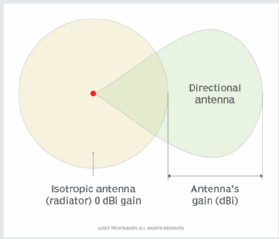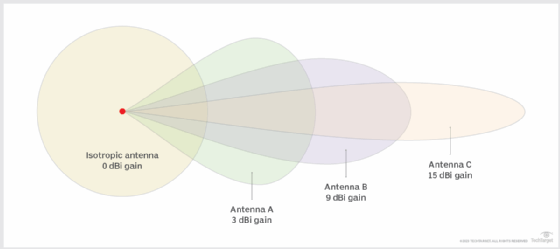decibels relative to isotropic (dBi)
What is decibels relative to isotropic (dBi)?
Decibels relative to isotropic (dBi) is a unit of measurement that describes how much power an antenna transmits in a single direction when compared to an isotropic radiator, which transmits in all directions at once. The difference between the two is called antenna gain, which is represented as a numerical value in dBi. The acronym dBi is also written out as decibels relative to isotrope, decibels relative to isotropic radiator, decibels over isotropic, decibels over isotropic antenna, decibels relative to an isotropic reference antenna and other variations.
What is antenna gain?
Gain is an indicator of how effectively an antenna can send or receive a signal compared to a theoretical antenna. When dBi is used to measure gain, the theoretical antenna is an isotropic radiator. An isotropic radiator is an antenna that transmits, or radiates, uniformly in all directions -- similar to how the sun radiates energy.
This contrasts with most real-world antennas, which distribute their energy in specific directions. The concentration of energy increases their ability to send signals in the target direction or receive signals from that direction, although it decreases it in other directions. This concentration also enables a directional antenna to significantly exceed the capabilities of an isotropic antenna for the target direction.

Figure 1 provides a cross-section view of the differences between an isotropic antenna and directional antenna, in terms of gain and signal strength.
How to determine antenna gain
When determining gain, the directional antenna is compared to the isotropic antenna, which serves as the baseline and, as such, has 0 dBi gain. The directional antenna's gain provides a measurement in dBi of how much the signal strength of the directional antenna exceeds that of the isotropic antenna. This amount is determined by comparing the electromagnetic (or power) intensities, measured in microwatts per square meter or some variation of wattage, of the directional and isotropic antennas at a given distance.
The following formula can be used to calculate an antenna's gain:
G(dBi) = 10 log10 (IX / IZ)
The electromagnetic intensity of the directional antenna is represented by IX, and the intensity of the isotropic antenna is represented by IZ. The formula first divides IX by IZ and then multiplies the quotient by 10 log10 to convert the amount to decibels. The final product is the directional antenna's gain in dBi, as represented by G(dBi).
An antenna's gain is directly related to its beamwidth, which is the angle at which most of the antenna's power is directed. Wider beamwidth provides smaller gain, but it delivers greater coverage. Conversely, narrower beamwidth yields higher gain, but it results in less coverage. Because of this, an antenna with a high gain -- and, consequently, a narrow beamwidth -- must be aimed more precisely at its target to send or receive signals successfully.
Figure 2 shows a cross-section view of an isotropic antenna and three directional antennas (A, B and C) with varying gains and beamwidths. Antenna A has the smallest gain, only 3 dBi, but it has the widest beamwidth; meanwhile, Antenna C has the largest gain, 15 dBi, but it has a narrow beamwidth.

What is another way to measure antenna gain?
Gain is not always measured against an isotropic antenna.
Another common approach is to use a dipole antenna as the baseline. A dipole antenna has a different radiation pattern than an isotropic antenna because of its shape, which is more like a donut than a sphere.
As a result, the dipole radiates energy unevenly, resulting in a gain of 2.15 dBi over the isotropic antenna in certain directions. When gain is based on a dipole prototype rather than isotropic, the gain's measurement is given in decibels relative to dipole, or dBd, rather than dBi.
